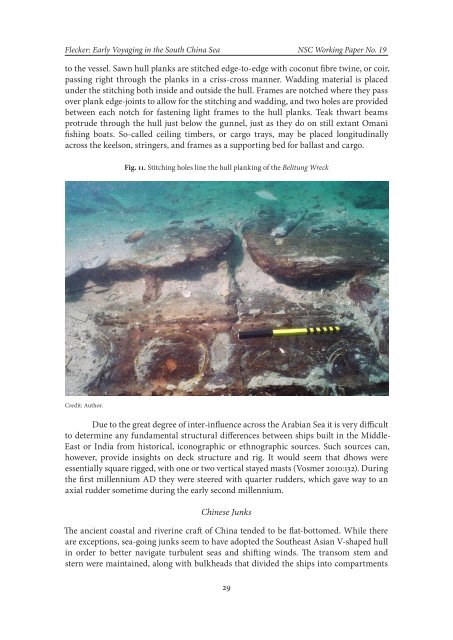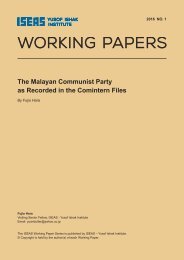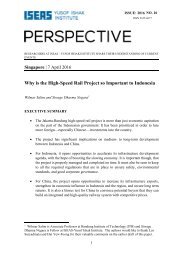NO.19
nscwps19_early_voyaging_south_china_sea_implications_territorial_claims
nscwps19_early_voyaging_south_china_sea_implications_territorial_claims
You also want an ePaper? Increase the reach of your titles
YUMPU automatically turns print PDFs into web optimized ePapers that Google loves.
Flecker: Early Voyaging in the South China Sea NSC Working Paper No. 19to the vessel. Sawn hull planks are stitched edge-to-edge with coconut fibre twine, or coir,passing right through the planks in a criss-cross manner. Wadding material is placedunder the stitching both inside and outside the hull. Frames are notched where they passover plank edge-joints to allow for the stitching and wadding, and two holes are providedbetween each notch for fastening light frames to the hull planks. Teak thwart beamsprotrude through the hull just below the gunnel, just as they do on still extant Omanifishing boats. So-called ceiling timbers, or cargo trays, may be placed longitudinallyacross the keelson, stringers, and frames as a supporting bed for ballast and cargo.Fig. 11. Stitching holes line the hull planking of the Belitung WreckCredit: Author.Due to the great degree of inter-influence across the Arabian Sea it is very difficultto determine any fundamental structural differences between ships built in the Middle-East or India from historical, iconographic or ethnographic sources. Such sources can,however, provide insights on deck structure and rig. It would seem that dhows wereessentially square rigged, with one or two vertical stayed masts (Vosmer 2010:132). Duringthe first millennium AD they were steered with quarter rudders, which gave way to anaxial rudder sometime during the early second millennium.Chinese JunksThe ancient coastal and riverine craft of China tended to be flat-bottomed. While thereare exceptions, sea-going junks seem to have adopted the Southeast Asian V-shaped hullin order to better navigate turbulent seas and shifting winds. The transom stem andstern were maintained, along with bulkheads that divided the ships into compartments29








